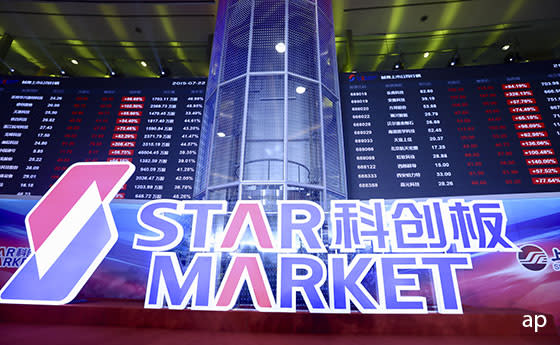China's Nasdaq Rival Starts Trading

Forty-eight years after the launch of the Nasdaq in New York, China’s first tech stock exchange has started trading. Shanghai’s Star Market consists of 25 stocks initially, with 100 companies having already applied to list on the exchange. Some 24 of the first 25 stocks are celebrating ther IPO as they list for the first time on the debut of the new exchange.
On a frenzied first day's trading, some firms saw their share price rocket as the exchange launched, including Anji Microelectronics Technology, which was up 400% by the close.
On the Star market, newly listed firms have no limits on their shares price increases or decreases in the first five days of trading, and after that will only be able to rise or fall by a maximum of 20% in a single day's trading. Loss-making firms are also able to list on the exchange, unlike on China's main market, which requires companies to have been profitable for at least two years in order to be eligible to list.
This is not the first time China has attempted to launch a rival to the Nasdaq; exchanges failed to get off the ground in 2009 and again in 2013 because of a lack of liquid stocks. But China’s status as an emerging market powerhouse was enhanced this year when China-A shares were included in the MSCI index for the first time.
ETF inflows into domestic stocks have already increased, Morningstar’s Jackie Choy says, and are set to grow further thus year. China A-shares will make up 3.3% of the MSCI Emerging Market index from November 2019, up from 0.7% at the start of the year. Choy the MSCI changes “are still just the first steps down the path towards integrating Chinese onshore equity markets into the global capital market”.
While an ETF tracking the Star Market is expected to be launched within weeks, tech investors should be aware that China’s globally recognised tech stars are actually listed outside the country – Alibaba (BABA) in New York and Tencent (00700) in Hong Kong. But Chinese authorities are hoping that a successful rival to the Nasdaq might tempt firms the next generation of tech stars to list on its domestic market. For comparison, Nasdaq has more than 3,000 listed companies, including Apple and Google parent company Alphabet.
While the Chinese government has warned retail investors not to speculate in shares, the launch of Star recalls events in 2015 when a share-buying frenzy sent Chinese markets to record highs. The Shanghai Composite Index broke through 5,000 points in the summer of 2015, only to fall back to 2,600 a year later. The index fell 25% last year as investors fled emerging markets because of a stronger dollar and the outbreak of the US-China trade war. Confidence has returned to global markets this year, lifting most indices, but while the US has posted record highs in recent weeks, China markets are still way below their 2015 highs.
Morningstar analyst Michael Wu, in his recent Asian Equity outlook, says that China-listed technology stocks have seen a lot of volatility in the past year because of the trade uncertainty, but that risk factors are now mostly priced in. He is also optimistic that the trade war will be resolved: “We continue to believe that a highly interwoven tech supply chain is quite difficult for the US and China to unwind, and therefore, the conflict will be settled eventually."

 Yahoo Finance
Yahoo Finance 